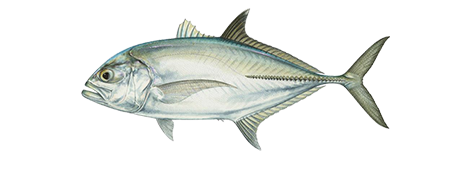Bigeye Trevally

Bigeye Trevally
In some areas of the Pacific, the bigeye trevally is a highly esteemed food fish
HOW TO IDENTIFY A BIGEYE TREVALLY
The maximum verified size of this species is 30 inches to the fork length. The breast is completely scaled and the body is not very deep, having a more elongated shape. The head is curved to a slightly pointed snout and the eyes are characteristically large. The lateral line is strongly curved anteriorly. The straight portion consists of 28-37 scutes. The first dorsal fin has 8 spines (rarely 7) and the second has one spine and 19-22 soft rays. The anal fin has 3 spines, 2 of which are detached, and 15-17 soft rays. There are a total of 20-25 gill rakers on the first branchial arch. There is a pair of lateral keels on either side of the caudal peduncle and the body color of the bigeye trevally ranges from silvery to dusky or dark, especially along the back. The dorsal fin lobe is dark with a white tip and the scutes are usually black. There is a dark spot on the gill cover, but no coloration is present on the pectoral fins. Juveniles of this species are golden yellow and have 4-7 broad, dark vertical bars on the body.
WHERE TO CATCH BIGEYE TREVALLY
The bigeye trevally is broadly found in tropical waters throughout the Indian and Pacific Oceans from east Africa to western America. It is found in rocky areas near shore as well as at outside reef drop-offs on the edge of deep tide-running channels, and in the deeper waters beyond the reef. This species is replaced in the Atlantic Ocean by its close relative, the horse-eye jack. The following list includes additional details on where to catch this fish:
Baitfish Patches Breakers Bays and Estuaries
Cliffs Channel Entrances Coastal Waters
Deep Shore Water Jetties and Breakwaters
Man-Made Structures Merging Water
Night Fishing Reefs, Wrecks and Shoals
Surf and Shore Shore Points Tidal Flats
HOW TO CATCH BIGEYE TREVALLY
Adults feed most actively at night, especially very dark nights. Diet includes eels and crustaceans, blennies, damselfish, and other fishes. Fishing methods include trolling baits and lures, using live or cut baits while drifting or at anchor, and surf fishing. Trolled lures or baits should be moved slowly among other bait fish or along the outside drop-offs of reefs or rocky ledges. Mullet, herring, sauries, garfish, anchovy, squid, or strip baits are used as well as jet head trolling lures, feathers, plastic jigs, plastic fish and squid, drone spoons and rope lures. The following are fishing methods used to catch this fish:
Jigging Drift Fishing Fly Fishing Bottom Bouncing
Bait Casting Surf Casting Still Fishing Spin Casting
Saltwater Trolling